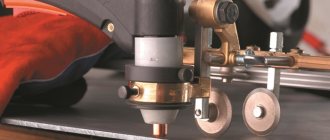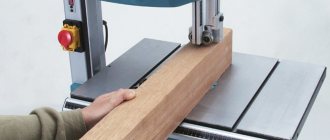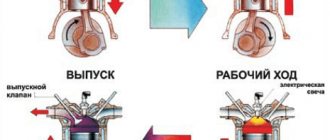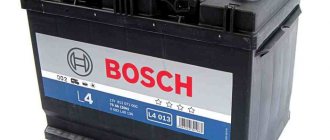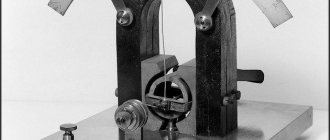A blowtorch is a heating device that produces high temperatures during the fiery combustion of flammable substances.
The combustion products that are produced during operation of the device form an elongated torch, and it has a very high temperature.
The gasoline lamp became the most popular . In addition to this modification, blowtorches, in which the flame source is natural gas, have become widespread. This type of blowtorch differs from other gasoline ones not only in the fuel spent on work, but also in the general design.
The volume of the tank used for fuel in the lamp can vary depending on the model of the device from 0.1 to two liters. The thermal power of such devices can range from 0.5 to 3 kW, depending on the method of fuel supply. The power of the light bulb will be regulated using a special tap, which opens the supply of burned gas.
Design features of a gasoline lamp
The structure of a gasoline lamp has two main structural parts - a reservoir for storing spare fuel and a burner. The components used in the operation of the device are:
- Alcohol.
- Petrol.
- Kerosene and other substances.
The burner is called an ejector. The ejector has a design that helps promote the overall flow of air and decaying combustion products during the combustion of most of the fuel. The process of operation of such a device consists of creating thrust through the combustion of a certain fuel.
During operation, a supply of fuel is poured into the tank, after which the container is closed with a tight lid with an additional seal. A lid with a seal protects the tank from fuel leakage during storage of this device, as well as during use. The tank for storing gasoline reserves has a special pumping device that helps pump air to create an increased level of pressure in it. Excess pressure helps, during operation of the device, to quickly and efficiently transport gasoline from the tank to the burner itself.
A typical device includes the following structural parts:
- A reservoir that is filled with fuel.
- Handle for holding the device while using it.
- Tightly closing neck for pouring fuel into the container.
- A pump with an additional valve - to create excess pressure in the tank.
- A siphon pipe that conducts fuel to the evaporator itself.
- The needle-type valve helps regulate the fuel supply to the device.
- Evaporator.
- Nozzle.
- Ejector.
- A device for cleaning the nozzle.
The fuel that is added to the storage tank is considered the main consumable. The quality of the fuel used will directly determine the smokiness of the flame and the clogging of the nozzle, as well as the level of explosion hazard of the device during its use. For high-quality and safe operation of the device on gasoline, you should use special gasoline or gasoline with an octane number of at least eighty. If low-quality fuel is used, the device may soon break down and will have to be repaired.
Do-it-yourself gasoline torch for soldering
First of all, it is important to say that gasoline burners made independently are no worse than factory ones. BG made by hand is just as productive and safe.
It is important to note that the temperature at the flame can exceed 1000 °C. Therefore, such a burner will easily melt refractory solders, perform heat treatment of small tools, melt various metals and even glass.
You will need:
- Frame.
- Fittings.
- Cotton wool (cotton and basalt).
- 2 valves for regulating the supply of the air-fuel mixture.
- Silicone pipes.
- Flexible plastic ties.
- Copper tube.
- Emphasis.
- Sealed metal can.
- O-rings.
- Pen.
- Rubber bulb.
- Filler.
The process of creating a gasoline burner with a compressor with your own hands:
- The body is created on a lathe; the workpiece can be a steel alloy of any grade. One end of the tube should be closed with a stopper, and the other will be open. It is necessary to drill a hole in the plug 0.2 mm larger than the supply tube. Then the housing will move successfully along the tube, while the tightness will be maintained.
- Several pieces of steel mesh and basalt wool should be inserted into the housing. This is done so that if the flame breaks out, the fire does not reach the fuel container.
- After this, it is important to make a sleeve with a hook and a resting element. It can be made from a sheet of steel 2-3 millimeters thick.
- The handle can be cut from ash or oak.
- Two through holes are drilled carefully. In this case, the projections of the drilled channels must be equidistant. Then the handle is sanded with sandpaper, then you need to apply 2-3 layers of colorless varnish.
- After this, the copper tubes are passed through the handle, after which they are sealed with refractory solder. Next, holes are drilled into them using a 0.3 mm drill.
- At the outlet of the tubes from the handles, 2 valves are installed, then there is a transition to silicone hoses. They are connected through fittings to a metal can, it is important to embed one fitting in the upper part of the can, and the second in the lower part, this is done so that concentrated gasoline vapors flow through one tube, and less saturated ones through the second. Don't forget to install O-rings on the fittings to prevent the mixture from leaking. The bottom of the jar is tightly packed with cotton wool. A bulb for pumping air is also connected to it.
- This completes the assembly, now you can fill the cotton wool with gasoline, seal the jar hermetically and test the device. To do this, air is pumped into the system with a blower, and then the combustible mixture supply screws are opened and set on fire.
Even such homemade gasoline burners will function properly, especially if you made the device according to our instructions.
Remember! If you do not have knowledge of the operation of burners and experience in using burners of this type, then it is better to buy a production version of the device.
Below you can see a photo of a DIY gasoline burner.
Lamp Specifications
A blowtorch is considered to be quite a useful device in any household. Tool models that are produced in Russia have different technical characteristics and different fuel consumption rates. There are several parameters that describe such devices. In order to make the right choice of the desired tool model, you should carefully study the technical parameters of the product. The main parameters for all devices will be the following:
- Capacity in the fuel tank.
- Optimal indicator of maximum filling of the tank with fuel.
- The maximum permissible pressure during operation of the device.
- Fuel consumption.
- Overall diameter of the device.
- Weight of the device not filled with fuel.
- Guarantees from the manufacturer.
- Operating time of the device.
The technical performance of a device determines its popularity among users. The most widely known devices are those that have a tank volume of about two liters. On such models there is a maximum filling indicator in the region of 1.5 to 1.8 liters, the maximum pressure value during operation of the device is 0.3 MPa. Fuel consumption reaches 1.2 liters per hour.
Operating principle of the device
After filling the fuel tank, air is pumped into the device using a special pump, which helps to create high pressure inside the fuel tank. Strong air pressure forces the fuel into the burner, where it is completely burned and a flame is formed. In order for the device to ignite and operate normally, it must be preheated to a certain level. For heating, a cup for fuel is used, which is placed under the burner itself. The container area of one cup is usually enough to heat the burner to the desired temperature.
When the desired temperature value is reached when the burner is heated, the fuel entering the device evaporates in the evaporator itself. Gaseous fuel enters the place of combustion and creation of a torch flame through a special jet. During combustion of the evaporated fuel material, excess oxygen is sucked in instead of the combustion process proceeding to maintain the overall reaction.
Scope of application of a blowtorch
A few decades ago, such a device was used if it was necessary to heat any surface or metal. This product was very often used in production, since they simply could not find any analogue for it. A blowtorch is used when it is necessary to produce heating in the absence of an alternative source of thermal energy or in the complete absence of modern technology.
In most cases, such a device is used:
- If it is not possible to use an electric soldering iron during operation, the device helps to very quickly heat up both the drive and the tip in the soldering iron.
- If you need to weld metal workpieces at a melting temperature below 1 thousand degrees Celsius.
- If necessary, melt a metal with a melting point of less than 900 degrees.
- The tool is used when it is necessary to remove the varnish coating from the surface of a metal item.
- While the car engine is warming up.
Sometimes the lamp is used to significantly loosen bolted and some other connections during dismantling of structures if the connections are heavily rusted. In addition, such a device is also used in agriculture during the slaughter of livestock to resin the animal’s skin.
Instructions for use
Before you start using the lamp, you should carefully study the instructions on how to use it for any construction work. You can use such a device only after reading the basic instructions and instructions.
The device may only be used outdoors. If there is an urgent need, then you can use the device indoors, but it only needs to be turned on for a short time, followed by good ventilation.
When using the device, you must strictly follow all operating rules:
- Before using the device, you need to fill it with the required amount of fuel. Filling the device container should be one third of the total volume. The empty volume should be used to create pressure during operation.
- Increased pressure must be created inside the device using a specially built-in pressure pump device. To create pressure, you need to perform about ten unsharp pumping motions.
- After obtaining high pressure, you need to add fuel to the burner bath. For this purpose, it would be best to use alcohol, since such fuel will not produce a lot of soot. The fuel poured into the tank is ignited to ensure the initial heating of the heating pad evaporator. During combustion of fuel in the bath, it is necessary to ensure special protection of the device from exposure to drafts.
- At the end of the combustion process of the fuel located inside the tank, the tight needle valve opens. The fuel coming from the evaporator itself must be of the gaseous type - if fuel drops appear in the flow, the evaporator heating procedure must be carried out again.
- After receiving a stream of gaseous fuel, it should be set on fire. If necessary, the volume of incoming fuel material can be adjusted independently using the needle cap. To speed up the process of heating the burner, you can place the device against a metal sheet, at which time the total distance from the sheet to the burner nozzle should reach two to three centimeters.
- During operation of the device, you need to carefully monitor the state of the torch - you can increase or decrease it using a gap-type needle valve.
- If during use the device is unstable or combustion extinguishes frequently, then you need to clean the nozzle using a special needle.
- At the end of the work, it is worth extinguishing the torch in the device. The torch is extinguished by screwing the valve and lowering the needle itself. After the lamp itself has cooled, you can release the air from the container.
When using the device, you must follow all safety rules.
Gasoline and kerosene
A blowtorch running on kerosene, like a gasoline one, consists of a tank in which the fuel is compressed to several atmospheres, and a burner. During compression, the fuel is partially mixed with air.
Reservoir and pump
The reservoir has a volume of 1-2 liters. Its body has a built-in filler plug, a pump to create pressure and a tube that connects the body to the burner, providing fuel to the latter.
To use the maximum amount of fuel from the tank and reduce the number of refills, the free “receiving” end of the tube is located almost at the bottom. All parts are built into the tank in such a way as to ensure tightness.
The simplest pump design is a cylinder with a piston. At the lower end of the cylinder there is a simple check valve that prevents air from escaping from the reservoir.
The piston is a cup-shaped cuff that compresses air when moving towards the cylinder valve, and when moving in the opposite direction, it allows air to flow, filling the cylinder.
Burner device
The burner consists of a nozzle, a control valve, an ejector tube and an ignition cup. From the injector, fuel is injected under pressure into a tube in which it is mixed with air captured from its rear hole.
To ensure complete combustion of the fuel, it must first be heated. This is ensured thanks to the design of the ejector tube. Fuel under pressure, before reaching the injector nozzle, is heated in the “jacket” of the tube, inside which a flame burns.
The initial heating of the tube is carried out when preparing the lamp for operation by igniting the fuel in the bowl. The adjusting screw ensures the required flame temperature by limiting the amount of injected fuel.
Fuel requirements
Fuel for use in a blowtorch must be clean, otherwise mechanical impurities may cause clogging of the nozzle.
For the same reason, it is recommended to use gasoline with a low octane number, as it contains fewer additives.
If the hole is clogged, it can be cleaned with a soft wire of suitable diameter. Steel wire should not be used so as not to damage the nozzle by changing its geometry. Very often, gasoline and kerosene blowtorches come with a special wire cleaner.
The difference between a gasoline and kerosene blowtorch is the diameter of the nozzle hole. In addition, in older designs of kerosene blowtorches, a small coil was located inside the ejector, which allowed the fuel to be heated more intensively. This design was a consequence of the fact that the combustion temperature of kerosene is slightly lower than that of gasoline.
Start and end of work
To start working, the device must be filled with fuel in an amount of no more than 2/3 of the volume of the fuel tank, and pressure must be created using a pump.
Then you should fill the burner bowl with fuel and carefully set it on fire. As the burner warms up, slowly open the control valve and increase the pressure in the tank.
When the fuel stream ignites, the nozzle nozzle must be directed into a fireproof, refractory surface, such as a brick wall or a sheet of asbestos. This will speed up the heating of the burner.
After completing the work, the flame is extinguished by stopping the fuel supply to the nozzle. Only after the lamp has cooled can the fuel tank be opened. It is allowed to refill the lamp if its temperature does not exceed 50 ℃.
Basic Precautions
When carrying out any work with the lamp, you must strictly follow safety rules. The thing is that violating the rules for working with the device can cause it to explode. A blowtorch is presented as a fire hazard. The fuel storage container is located very close to the open flame of the torch itself.
When using the device, you must follow some rules:
- Do not use the tool while detecting gas or fuel vapor leaks.
- It is prohibited to use fuel when using the lamp, which in its characteristics does not meet the requirements of the manufacturer.
- It is forbidden to use the device for a long time, as the proximity of the burner may develop the risk of heating the fuel cylinder above 50 degrees Celsius.
- The device should not be used while the safety valve is faulty.
- It is prohibited to fill the tank with fuel while the burner is burning.
- It is better not to use the device unless absolutely necessary in a closed room; it is unsafe.
It should also be noted that failure to comply with any item from the list of safety rules when using a blowtorch can cause an explosion and unpleasant consequences for a person. You should always follow simple instructions for use, which will allow you to achieve maximum efficiency of the device during its operation.
Gas
A gas blowtorch works using liquefied propane or butane, packaged in metal cans, as fuel. In this case, the tool itself is usually a portable burner, and gas cylinders can be purchased separately.
All connecting connectors of burners and cylinders are unified, and almost all cylinders are easily connected to any type of burners.
The burner of such a blowtorch is a tube open at one end (this is the burner nozzle). On the other side there is a nozzle mounted.
There are also several holes for drawing air into the nozzle and subsequent mixing with gas, which is necessary to create a flame with a high temperature. The temperature and flame intensity are adjusted using a tap located on the burner body.
Operation of such a device begins with opening the tap to an amount that allows a small amount of gas to be released from the cylinder, and igniting it with a lighter or match.
For intensive use and if it is necessary to frequently ignite and extinguish the flame, it will be more convenient to use a gas blowtorch with piezo ignition.

